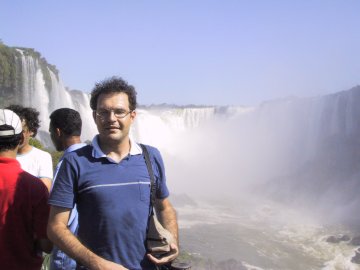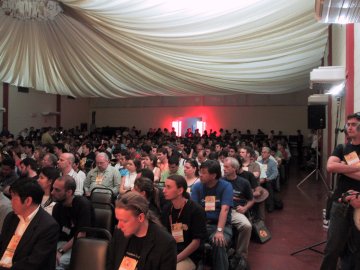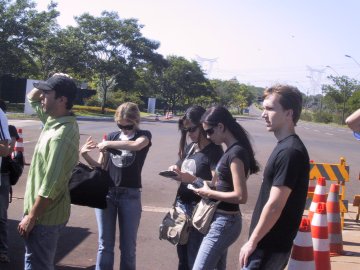November 20, 2006
gnome, wengo
Comments Off on Foz do Iguaçu – water, lots of it
I was in Brazil last week, thanks to the funding of the GNOME Foundation, at Latinoware, giving a presentation “Getting started in free software” – a personal description of how I got involved in free software, and the lessons I have learned through it. I spoke about my experiences in the free software world, including my time with the GIMP,GNOME and OpenWengo. Before going, I didn’t really know what to expect. This was my first visit to South America, and while I had heard lots of good things about the free software community there, nothing prepared me for what we saw.

Joao Bueno of the GIMP at the falls
Foz do Iguaçu is a small town in Western Brazil dominated by two impressive landmarks – the Iguaçu falls, a dazzling array of waterfalls that stretched for several kilometers on the Argentina-Brazil border, and the hydro-electric power station at Itaipu, the biggest operational hydro-electric power station in the world. Latinoware was held in the grounds of Itaipu, about 2 kilometers from the dam.
On Wednesday, I got to visit the falls – an amazing experience. The array of wildlife on show is unbelievable, with Toucans, lizards, spiders, and the Wilber-like coati, the mascot of the town. And then there is the falls. According to Wikipedia, they consist of about 270 waterfalls, along a 2.7 km stretch of the Iguaçu river which divides Brazil from Argentina.
Itaipu is also amazing. The power station generates 25% of all of the electricity needs of Brazil, and 95% of the needs of Paraguay. One turbine of the Itaipu plant is 10 meters in diameter, and generates 700 MW of energy – more than enough to fulfill the needs of a city the size of Lyon.
I also got to visit Ciudad del Este, a free trade zone in Paraguay, across the Parana river from Foz. It reminded me of those no-man’s-land cities you occasionally see in spy films. This one city represents 60% of Paraguay’s GDP. You could buy anything – electronics, arms and clothes are apparently the most popular items.

The amazing Latinoware crowd
Thursday morning, I gave my keynote presentation in Itaipu. As I said, I didn’t know what to expect – the last thing I was expecting was 1200 free software advocates, mostly between 18 and 25 years old, coming to the conference. Aside from the size and age of the crowd, one other thing surprised me – the amount of women. A rough estimate put the number of female participants between 10 and 20 percent – coming from Europe, where we’re used to counting on the fingers of a few hands the number of women at a free software conference, seeing hundreds of women at the conference was a refreshing change. One last surprise was waiting for me in the opening addresses – several politicians, including Marcus Mazzoni, a former guest at GUADEC, and member of the regional government in the state of Parana, spoke of free software not just as a way of cutting costs, but first and foremost about sharing and community. First and foremost, free software is a social and cultural phenomenon in Brazil. I doubt many French politicians understand so well what free software is all about.

Women in Free Software
My presentation went well, I think – perhaps because the point above is one I hold close to heart. Free software is all about communities forming around ideas, and those communities are human. Almost everyone who gets involved in free software development gets involved through a friend. I also talk about the motivating factors people have which make free software attractive to them – and the thing that ties us together, I think, is the feeling that we’re part of something bigger than ourselves, that we’re taking part in a movement, which is slowly changing the way the world sees technology, and the way technology gets created. We are changing the world.
November 15, 2006
gnome, marketing
6 Comments
It’s my first visit to Brasil, I’m still in Sao Paolo airport, and my first impressions are not yet made.
My first impressions of airports have been made for years, though, and nothing here changes any of my experience-driven broad generalisations.
“Duty Free” booze in Paris was more expensive than the same stuff in the superstore – they made up for it by having a good range of €100 – €500 collector bottles. Meh.
I bought a beer here in Sao Paolo airport, and paid twice what I would outside the airport (6 reals), and have spent 40 reals on international call cards and 20 reals on 2 hours wifi.
The exchange rate is somewhere between 2.30 and 3.00 reals per euro, depending on how badly you’re getting fleeced by the bureau de change, and whether you’re buying or selling euros. So taking 2.50 and a rough rate, that’s 8 euros for 2 hours wifi – which is expensive anywhere, never mind in Brasil. And I can’t figure out how to find an SMTP server I can send mail through.
Am I the only one who finds the mentality of fleecing international air travelers at every opportunity is really counter-productive? Surely places would like to make a good first impression? How about doing away with airport surcharges for taxis, and making an airport discount for anyone coming off an international flight?
I just found out that because of a last-minute conference rescheduling, I’ll be giving a keynote at Latinoware – talk about adding pressure. I tested the new laptop (a Dell D420, which does indeed rock once you get the widescreen sorted) with a CRT behind it, and it didn’t work too well – I’m hoping that by stopping the 915resolution hack at boot and constraining it to 1024×768 the projector will work. If not, I have not yet completely removed windows, dual boot to the rescue.
November 9, 2006
gnome, marketing, wengo
1 Comment
Next week, I will be in Foz do Iguaçu in Brasil, to attend Latinoware 2006. I will be giving a conference on how and why we do free software – not so much from a technical point of view, but from a human perspective. It will be pretty similar to the presentation I gave last month in Lyon at les Journées du Logiciels Libres in Lyon, France.
This will be my first time in Brasil, and I am very excited about it – I hope I get a chance to go and see the falls – I’ve heard great things about the Devil’s Throat. I’d also love to get a chance (but I don’t think I’ll have time) to take in Itaipu, the world’s second largest hydro-electric power station after the Three Gorges in China, and a big GNOME user.
November 5, 2006
wengo
5 Comments
Last Tuesday, I finished up with Cegelec – I had a nice time working there, and a really good spirit in our small team working on air quality software, so I will miss it a little, I think.
But not much, because starting tomorrow, I will officially be working for Wengo on the project OpenWengo.

I have butterflies – I have started to get to know the project over the past couple of months, and I’m looking forward to having more time to dive in and work on some of the issues the community has been having. It’s a great project, with great potential, and I’m hopeful I won’t piss everyone off too much for at least a couple of months.
October 27, 2006
General
Comments Off on Lyon Firefox 2.0 Party
This evening, Lyon celebrates the release of Firefox 2.0.
The party starts after 18h, in the Cavern, 11 rue des Trois Mariés – a new pub in the Vieux Lyon run by a Paddy, a Frog and a Canuck. So if you’re in the area, come along, there’s wifi, darts and maybe some beer.
October 25, 2006
marketing
9 Comments
I got some interesting responses to my post yesterday, most of which missed my point.
Talking about freedom, choice and community does not equate to preaching. Nor does it necessarily equate to talking about Open Source or Free software. When I say we should be talking about freedom & choice, I’m talking about the *user’s* freedom & choice, not the developer’s.
My favourite Firefox Flicks entry was “Daredevil”. Whee was fun, all the ones talking about spyware and privacy or viruses were OK, but the one that got me was the one that concentrated on a value – user freedom.
Think of all the car ads which associate their product with freedom. Even Microsoft use the concept of freedom with their “realize your potential” ad campaign.
Ignoring such a powerful concept, which we *own*, seems to me like suicide. “We’re the nicer browser to use” will work for a while, but one day that may well not be the case (especially since it’s a subjective question, and Microsoft has a bigger marketing budget). And when that day comes, Mozilla will start losing share, unless people have established an emotional link with Firefox.
Are we really not smart enough to come up with a good way to make a free software user feel free? Or to present ourselves as the champions of choice? Is there really no value in trying to make a Firefox user feel like part of a greater community?
October 24, 2006
marketing
17 Comments
Mozilla Firefox 2 marketing will focus on functionality and the chase for market share, rather than the fact that it’s free software.
I am not the only one who is disturbed by this strategy. That’s not because I’m a free software zealot, but because I think it’s a losing game.
To win this battle, we need to speak to people’s souls – if we only concentrate on the surface, then Microsoft will win – they will add more functionality, make IE more usable, build a better browser the way they did in 1997 and 1998. Mozilla can always cry the pyrrhic victory – “we restored choice on the internet” – but once their market share starts to go down, they will have lost – because that’s how they’ve chosen to play the game.
If, on the other hand, we concentrate on values that Microsoft don’t have, and can’t compete on, then we will capture hearts, and market share will follow. Freedom, choice, open standards, community – these values will generate passion. Will they disturb some people? Sure. But you can’t win ’em all. An ounce of passion is worth more than a pound of mediocrity.
October 20, 2006
General
Comments Off on And the mystery guest is…
Pour ceux qui ont vu ma présentation la semaine dernière, et qui n’ont pas reconnu le visage (ou qui l’ont reconnu, et qui se sont amusés à voir mon trou de mémoire): Blake Ross.
October 17, 2006
gnome
3 Comments
I announced a couple of days ago the availability of a position working for the GNOME Foundation. It’s an interesting position, I think, and worth explaining a bit further.
The foundation’s director of business development is the person who will generate revenues for the foundation. For the past few years, the foundation’s budget have been languishing around $150,000 to $200,000, which is enough to pay the wages and expenses of the executive director, and to organise GUADEC.
This year, we’ve made some progress, and the accounts for 2005/2006 should be close to $300,000 – thanks to some new advisory board members, a couple of very generous donations, and a very successful sponsorship drive for GUADEC.
This means that we’re able to move from one employee to one and a half – a part-time position to deal with administrative issues, and a full-time position to concentrate on further developing our budget, and managing that budget.
Some of the ideas that I have had for things we could do with more money are:
- Hire a systems administrator
- Hire a bugmaster to co-ordinate with downstream distributions
- Hire a community facilitator to co-ordinate the work of user groups and ensure communication between groups and companies
- Get GNOME documentation professionally edited and published
- Invest heavily in GNOME t-shirts, merchandising, posters and hand-out printing for GNOME conference presence
Note that none of these positions generate code – it is my opinion that it’s not appropriate for the GNOME Foundation to hire coders. However, hiring people who help make our coders more productive, and makes our community a nicer place to be, is a good investment.
The types of avenues that I hope our director of bizdev will be exploring are government grants, partnerships with companies using and developing on GNOME, and relationships with public sector organisations worldwide.
The GNOME brand itself isn’t very visible to end-users, but it is of strategic importance to all major desktop distributors, and has a great reputation and a cult following. The director of business development will help us build on that reputation, and will give us the tools necessary to make the GNOME platform great for ISDs, and the desktop great for everyone from the public sector to the free software hacker.
October 16, 2006
gnome
1 Comment
A common complaint about the GNOME Foundation and the foundation board is that people really have no idea what kind of foundation-related stuff is going on. Information comes in drips and drabs, and if you link together a series of minutes from the board meetings, you can see an outline of what we’re doing.
Much of what the board does happens on the mailing list, and we haven’t been very good at communicating that kind of activity.
A lot of what happens around the foundation doesn’t even involve the board, but comes from initiatives by foundation members or subcommittees.
So in an attempt to rectify this, here is a rough list of some of the things that the foundation has been involved with over the past year. Some of them might be surprising, others are probably taken for granted. I’m hoping that seeing the list written down will give people a better idea of what we do (which is mostly delegation).
- GUADEC: support the GUADEC team, provide organisational infrastructure, fundraising (raised over €100,000)
- Spent €40,000 bringing hackers to Barcelona
- Foundation administration: Hired Zana Yuen as part-time administrator
- Supervised Andrew Case’s public service (the first time, to my knowledge, that working on free software has been recognised as public service)
- Co-funded a Blender/GNOME stand at SIGGRAPH
- Funded one European and one American event box for conference participation
- Ensured a presence in a number of free software events around the world
- Supported local GNOME events around the world
- Supported travel expenses for participation of GNOME hackers in some events like OSDL desktop architects summit
- Finally got approval for the GNOME trademark
- Create a legal working group to avoid the kind of delays we’ve seen handling legal issues in the past
- Improve the operation of the membership committee, and get some new members on there
- Increased the advisory board from 7 members to 14, including Nokia, Intel and Canonical
- Finally have a decent GNOME brand book thanks to Mairin Duffy, and working towards improving GNOME’s community trademark usage guidelines
- Organise a couple of summits
- Contract Shaun McCance to write some documentation for ISVs
- Launch the GNOME Mobile and Embedded initiative
- Joined a number of new initiatives, including OSDL’s desktop architects, OSSI, the Open Source Consortium and COPU in China
- Improve frequency and quality of interraction with the advisory board
- Finally get a handle on the foundation’s finances
- Establish a budget for marketing
- Improve financial transparency
- Start organising local user groups
Not to mention a number of other initiatives which are currently in progress, which were initiated by the foundation, or by the foundation board.
- Contacted O’Reilly & Associates about the possibility of publishing a GNOME book for ISVs based on existing technical docs
- Contacted merchandising companies about the creation of a GNOME store (or many GNOME stores)
- Finally getting the website updated and streamlined
- Working on a proposal for improved technical governance in the project
- Initiate hire of foundation director of business development (in progress)
« Previous Entries Next Entries »



